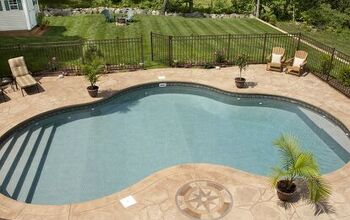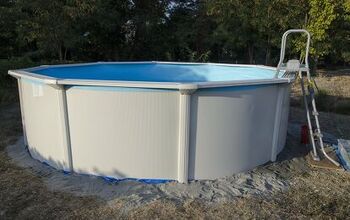Can You Patch A Pool Liner With Water In It? (Find Out Now!)

If there is one thing that I’ve learned by doing tons of writing and research on the topic of pool liners, it’s that they tear. And when they usually do, it tends to be when water is in the pool. The most obvious way to patch up a pool liner would be to drain the pool. But, what if you don’t want to drain your pool? Can you patch a wet pool?
Believe it or not, it’s possible to patch up your pool liner while there is water still in it—at least, in most cases. It’s easy enough to do as long as you use a wet patch or Flex Seal to do it. If you try to use a dry patch, then you will need to empty out your pool.
You can make the most of your patching time by knowing what can and cannot be done…and how to do it. Here’s a guide that will help you do both.
Do You a Need Pool, Spa, or Hot Tub Contractor?
Get free, zero-commitment quotes from pro contractors near you.

Is It Safe To Patch A Pool Liner With Water In It?
It is absolutely safe to patch your pool liner, even when there is water in it. However, it may be a bit trickier. It’s important to choose the right patch when you do it. If your pool has drained out water where the liner tore and exposed it to air, you can use a dry patch. However, if the actual leak is inside the water and you can see it, then it’s time to act with one of these items.
Before We Patch: The Pre-Patch Basics
We are going to go under the assumption that you have already verified that you have a pool liner that’s actually leaking rather than evaporation or low water levels. If you just saw your pool start to leak, slap on some water-friendly duct tape to temporarily seal the leak. Then, head off to your local hardware store to get a better solution.
Note: Do not drain your pool. This can actually harm your pool further and may make it hard for you to do things right. If the pool drained itself during the leak, it was not avoidable. Draining the pool is something you should almost never do, period.
How Do You Patch A Pool Liner Tear Underwater?
Now that we’ve gone over the sanity check, it’s time to take a look at how you can patch it using some of the best methods on the market right now.
Wet Patches
Wet patches are the traditional way to repair a pool leak. You will need to make sure that you have both the wet patch and the adhesive that is appropriate for it. Once you have them, do the following:
- Cut the wet patch to size. It should have two inches extra on every edge near the leak.
- Apply adhesive with your dauber. Don’t be stingy with it. Glob it on, especially around the edges
- Fold the patch in half, sticky side out. This makes it easier to bring it into the water and keep a grip on it.
- Slowly apply the patch, one side after the other. It’s best to start applying the patch from the top down. Use your hand to slowly slide down the pool.
- Hold the patch in place for 2 minutes. Do not try to tug at it.
- Let the patch sit afterward. If it’s possible, apply weight for the next 24 hours. If not, don’t panic.
Flex Seal
Flex Seal is one of the better products on there for fast pool patching. We suggest using Flex Seal tape right over the area that’s torn. It’s just like using regular duct tape, except way better. It’s also about as permanent (if not more so) than a wet patch.
Peel N’ Stick Patches
Lately, there have been several companies that came out with their own “peel n’ stick” wet patches for pool use. As the name suggests, these don’t require you to apply the adhesive to the patch. It’s already there. Some might not even require you to trim the patch, though we strongly suggest doing it if at all possible.
Peel n’ stick patches are a good choice if you have small tears and petite holes. They don’t always have the holding power that most other wet patches do. If you get a “pre-glued” patch, make sure that it is made for wet patching or underwater repairs. Otherwise, it won’t stick.
Do You a Need Pool, Spa, or Hot Tub Contractor?
Get free, zero-commitment quotes from pro contractors near you.

Related Questions
How long do pool liner patches last?
It’s hard to tell, simply because every leak is different and every patch is different. Pool liner patches are never meant to be permanent, so don’t expect them to stay for 15 years. In most cases, a typical patch will last for three to five years. If you use Flex Seal or similar tapes, you may be fortunate enough to get seven years or more.However, size matters too. Larger patches have a shorter lifespan. Shorter patches tend to have a longer lifespan.
Are pool liners easy to tear?
It depends on the liner’s age, really. The younger the liner, the more durable and stretchy it will be. As the liner ages, the vinyl will lose its “give.” This makes it brittle and prone to snapping. Pool liners are going to be unable to avoid tears after a certain point, simply because vinyl tends to degrade over time. If you are worried about your pool liner failing, then it is probably time to get a new liner or replace your liner with gunite.
Do gunite pools need a vinyl liner too?
Gunite pools can get a liner, but by no means are they necessary. Since gunite is made from concrete, there is no need to add further protection through the use of a liner. Even without a liner, gunite pools will be able to last for as long 100 years. So you really don’t need to bother with a liner unless you have a full-on preference for pools that have a liner in them. It’s a thing, especially among aesthetic types.

Ossiana Tepfenhart is an expert writer, focusing on interior design and general home tips. Writing is her life, and it's what she does best. Her interests include art and real estate investments.
More by Ossiana Tepfenhart



























